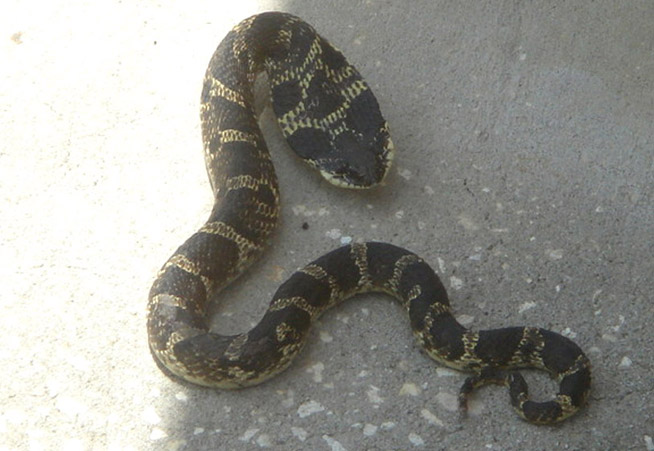
Biology:
The southern hognose snake (heterodon simus) is a small snake that is native to the southeastern region of the continental United States. The southern hognose has a broad neck and its body is relatively wide relative to its short length. Southern hognoses are fairly short snakes, with a total length usually under half a meter and sometimes only a third of a meter. Rare specimens can reach nearly three-fourths of a meter in length.
The coloration of these snakes can vary considerably, but often they are anything from a red or light brown color to gray or yellow or even slightly green. Over the base coloration there are several large, dark spots with lighter margins, along with smaller spots along the flanks of the snake’s body. The underbelly of an adult southern hognose is typically lighter in color than the main base color of the top of the snake. However, in a young southern hognose the belly tends to be of a darker hue than the bottom of the tail.
Like other snakes in the hognose group, the southern hognose snake has an upturned snout. The southern hognose’s upturned snout somewhat resembles the beak of a duck or the end of a cowboy boot. This creates an appearance that many snake enthusiasts find either endearingly ugly or just plain unattractive.
Other people find the southern hognose snake to have a rather menacing appearance. However, the truth is that this snake is completely harmless to humans. This is because the southern hognose is completely nonaggressive towards people. Furthermore, like most snakes in the colubrid family it does not produce venom. This means that even if a southern hognose snake decided to bite a human, other than a slight risk of infection the person would probably be okay.
As a word of caution, it should be noted that the southern hognose is easily confused with the pigmy rattlesnake because of their similar appearance. Unlike the southern hognose however, a pigmy rattlesnake can deliver a very painful and rarely fatal venomous bite. Never attempt to handle a snake unless a professional has identified it as safe.
Habitat:
The southern hognose snake can be found throughout the southeastern United States. Its known habitats are in North Carolina, South Carolina, Georgia, Florida, Alabama, and Mississippi. Most of its known habitats are within 100 miles of the coast or along areas that have been flattened by riverbeds.
Preferring drier areas rather than damp areas like many other snakes, the southern hognose is most likely to be found in dry river beds, grassy fields, or other open, dry and flat areas.
As an endangered species, the southern hognose is on the brink of extinction. Little is understood as to the cause of the rapid population loss of the southern hognose. However, likely contributors are the destruction of the southern hognose’s natural habitat as once rural areas of Florida and other coastal areas in the south become highly urbanized and developed, and the exploitation of land for commercial purposes. It is also possible that the introduction of non-native species into the ecosystems of the south is having an impact on this snake’s population.
Because of its threatened status, it is important that serious conservation efforts are undertaken to preserve the southern hognose’s delicate natural habitats. The southern hognose is facing the most dramatic population loss in Mississippi and Alabama.
Behaviour:
Since the southern hognose is very shy and secretive, it is extremely hard to catch a glimpse of this rare creature. The southern hognose is fossorial, which means that it prefers to spend its time buried underground and out of sight of potential danger such as humans.
They are also known to play dead if they feel threatened. When they do this they will often roll over and stick their tongue out as though they were dead. Another quite different response to danger is to make a big threatening display in which the snake tries to bluff its perceived attacker into thinking it is dangerous. In reality though, the southern hognose is quite harmless and nonvenomous.
Diet:
Like all snakes, the southern hognose is a carnivore, meaning it eats only other animals. Unlike other snakes however, this snake subsists almost entirely on one animal: the toad.
Reproductive:
The southern hognose is an oviparous animal, meaning that the mother lays eggs rather than birthing live young. Typically she will lay anywhere from five to fifteen eggs. However, because the animals are so rare and secretive little is known about their breeding habits. It is known that they breed in the springtime.
Many people want to know how to kill a Southern Hognose Snake, but you don't need to. The
best way to get rid of Southern Hognose Snakes is to simply leave them alone. You can also
use a Southern Hognose Snake trap to catch them - that's one of the best ways for how to
remove Southern Hognose Snake. For more information, go to my
Snake Removal - How to Get Rid of Snakes home page.
If you need Southern Hognose Snake removal in your city, I have friends that I have
personally trained in many cities.